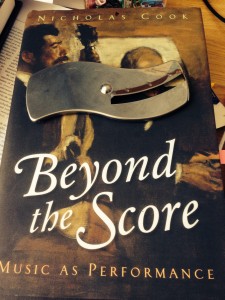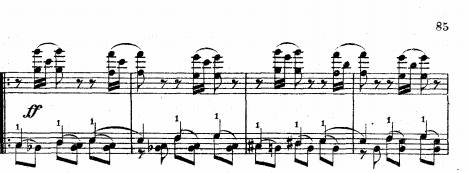
By what turns out to be a happy coincidence, I managed this week to combine reading Nicholas Cook’s Beyond the Score: Music as Performance with an accident in which I sliced the end of the fourth finger on my right hand while I was washing up the blade of a food processor (see illustration on the left). I picked it up and turned it so I could make it really nice and clean, and of course, in doing so, I made a little manual food processor in the sink, to which my finger fell victim. Needless to say, for a pianist, this is bad news. Since it hurt so much to put any pressure on that finger, I didn’t even try until I really had to, which was a class & rehearsal last Thursday night. One attempt to play on it during pliés was all it took to realise that I’d have to change my usual piano fingering so that I could play everything without a fourth RH finger. That made quite a difference to tunes that I usually play almost the same way every time: a lot more clarity and power in the phrasing, because you’re not weakening your tune-playing fingers by trying to do other stuff at the same time.
Schenker and piano fingering
As I was playing, I thought of a passage in Beyond the Score where Cook describes Schenker’s disdain for the ‘cult of velocity’ and the 19th century idea of all-purpose fingering systems. Schenker argued that each piece had it’s own ‘special fingering’ and ‘special dynamics’ (Schenker 2000:77, cited in Cook 2013: 41). His own style of piano fingering was apparently aimed at bringing out the sense of the music rather than being convenient physically. He (Schenker) was critical of Broadwood’s English action, saying that
perfect evenness of touch has arrived. Simultaneously, music training has for decades striven for perfect evenness also of the fingers. Thus, we are faced with evenness of fingers and keys. We could be pleased by this development if – what irony! – precisely the opposite were not the crux of the matter: unevenness! The fingers, by nature uneven, must play unevenly: all effort in practicing is in vain if it does not aim at unevenness in performance. (Schenker 2000: 77, cited in Cook 2014: 42) [scroll to the end for references]
I remember having a mental jolt when I read that, given that my entire pianistic life has been spent in the pursuit of exactly what Schenker criticised. I don’t think my teachers drummed it into me – two of my teachers, Trissie Cox and Antony Saunders, would often suggest unusual fingerings like playing a motif in the left hand with your thumb to give it oomph, or sliding from a black key to a white one with the same finger, and then there’s the trick of fingering mordents 1-3-2. But the aim for evenness of touch is all around you – Czerny, Hanon, and those endless scales and arpeggios that you learn for ABRSM exams.
Schenkerian piano fingering – an example from La Sylphide
I thought no more of it until last Thursday night when I had to play the reel from La Sylphide, which, I can tell you, is pretty hard without a fourth finger. When it got to the B flat section, I realised with the clarity that only having sliced your finger with a blade gives you, that Schenker was brilliantly right about this. Previously, I’d have done the physically convenient thing, and fingered the opening D-Eflat-F in the right hand with the fingering 3-4-5, which makes the whole bar lie under one hand position. But there was no way I could do that this time, and in the heat of the moment, I came out with the fingering below:

This section looks so much fun on paper, but it never sounded as good as I wanted it to until I put this “emergency” fingering into action. It’s a bit messy – especially the hopping over your own thumb to play the quaver B flat on the second half of the second beat in the first bar – but it sounds a whole lot better musically than starting with 3-4-5 and using the same hand position for the whole bar. If you finger the slide up to the F with 1-2-3, you get a real punch out of the F and a lot of ring out of the appoggiatura. By hopping from 1 to 1 on the C and D on beats 3 and 4, you get a much better staccato than fingering it 2-4-3-5. And that hop over the thumb to play the B flat with 2 results in a light staccato for that note – whereas with the ‘convenient’ fingering, this relatively weak beat/note gets the whole weight of your thumb.
Chord voicing and piano fingering
Another insight was chord voicing. The standard pattern for a big chord in the RH is an octave with two filler notes. By the time I’d accidentally hit my injured finger a few times during the piece, there was no way I was going to hit it again for the sake of a major third that was already present in the bass (the chord was a first inversion F major in the right, ACFA, with an octave F in the left) so I missed it out. I realised then that trying to play four-note chords because you can is pretty pointless. Including the fourth finger weakens the attack that you can give to your fifth. The 4th is weak, so you don’t get a lot of sound out whatever note is under it. So, frankly, why bother? Why not try different voicings, and if missing out a note actually sounds better, do it.
Piano fingering in Snowflakes from The Nutcracker
Next on the playlist was “Snowflakes” from The Nutcracker, and for the first time in my life, those twiddles in the right hand actually sounded like a piccolo, because I had to play all of them 1-3-1 rather than sort out how to avoid using my 4th finger. Interestingly, one of the only places where Taneev indicates fingering is during this massive countermelody in the bass – for which he suggests a thumb on every note. Combine that with 1-3-1 for the right hand notes (forget about the lower octaves – they add little, compared to what leaving them out enables you to do, I discovered), and this begins to sound a lot more like an orchestra.

So the happy part of the coincidence is that this embodied-knowledge encounter with a food processor blade, combined with Cook’s wonderful scholarship, made Schenker’s thoughts on pianism come to life in fascinating, practical ways. It’s rather a messy, bloody and painful way to enlightenment, though. Save yourself the trouble – take Schenker’s word for it, and discover what relying on the unevenness of your fingers can do for making your playing sound more musical.
References
Cook, Nicholas. 2013. Beyond the Score: Music as Performance. New York: Oxford University Press.
Schenker, Heinrich. 2000. The Art of Performance. Heribert Esser, ed., Irene Schreier Scott, trans. New York: Oxford University Press


Respect! 🙂
Your post reminds me of a quote by Chopin that I discovered here http://www.forte-piano-pianissimo.com/ChopintheTeacher.html several weeks ago:
“For a long time we have been acting against nature by training our fingers to be all equally powerful. As each finger is differently formed, it’s better not to attempt to destroy the particular charm of each one’s touch but on the contrary to develop it. Each finger’s power is determined by its shape: the thumb having the most power, being the broadest, shortest and freest; the fifth [finger] as the other extremity of the hand; the third as the middle and the pivot; then the second [illegible]. And then the fourth, the weakest one, the Siamese twin of the third, bound to it by a common ligament, and which people insist on trying to separate from the third-which is impossible, and, fortunately, unnecessary. As many different sounds as there are fingers.”
Limits often lead to breakthroughs. While I’m a grateful recipient of the wisdom and insight you gained through your experience, I do hope your finger heals quickly and that you are spared from an encore performance. 🙂
What a great quote, thank you so much for posting this. It’s fascinating that this challenge to received wisdom should have been around for so long, much longer than Schenker’s “many decades” seems to suggest. Thanks for the kind wishes – it’s getting better, but I am almost glad it happened for the insight it gave me! However, I’ve decided I have to be more careful in the kitchen – the only other two major injuries I’ve had were a) With a lemon squeezer (hand slipped, twisted my RH index finger and couldn’t bend it for a few weeks, needed physio to get it back to normal) b) Washing up a cheap wine glass that broke as I twisted it, making a deep spiral cut right round my RH index finger.